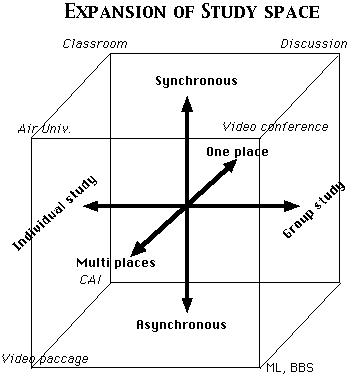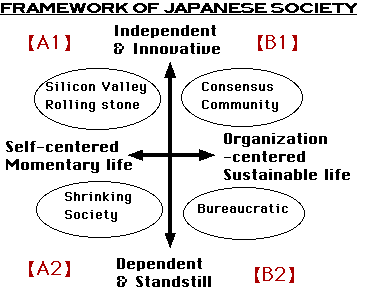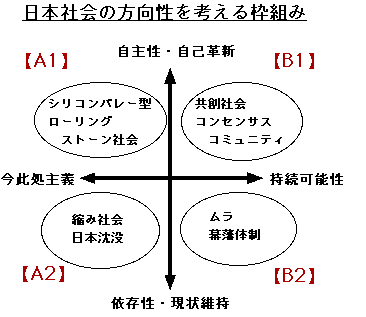Summary |
要約 |
>Top
1. Expansion of study space:
- Population of 18-agers in Japan was
 about 2.05 million in 1992,
is estimated about 1.2 million in 2010. about 2.05 million in 1992,
is estimated about 1.2 million in 2010.
- The trend of less children and more aging people is sure to change
Japanese social structure. Demand for adult education increases,
while numbers of university also increases. What will be the higher
education system by development of Information media technology?
Or in other words, 'E-Learning Society and Ever Learning Society'
is the main issue.
- IT expanded time and space for study in the following dimension:
- 1) from 'Synchronous' to 'Asynchronous',
- 2) from 'One place' education to 'Multi places',
- 3) from 'Individual Study' to 'Group Study'.
- The change was related to methodology of education, directing
1) from teacher-oriented education to learners-oriented, and 2)
from systematic or hierarchical 'Instructivism' to emphasis of learners
intention, experience and way of recognition, called as 'Constructivism'.
|
1.オンライン教育の課題:
- 日本では18歳人口が1992年の約205万人から、2010年には約120万人へと減少すること は確実である。
- 少子高齢化という不可避的な社会構造の変化をもたらし、社会人教育の 需要が増大している一方で、大学数もむしろ増大している。これらを背景に、情報メディア技
術の発展の中での高等教育の構造変化、E-Learning Society & Ever Learning Societyの課題が今回のテーマである。
- まず情報化によって学習が行われる時間・空間が変化した。即ち、
- 1) 同期から非同期へ、
- 2) 集合 (一地点)から分散 (多地点)、
- 3) 個別学習から共学習
へと学習形態 が拡張されてきた。
- その拡張方向は、1)教師中心から学習者中心へ、また、2)体系的・階層的な 教化主義(Instructivism)から学習者の意思・経験・認知の仕方を重視する構成主義
(Constructivism) へと、教育法のあり方にも関連する。
|
>Top
2. Paradox of "eLearning":
- Why informatization of education, or eLearning is used in the
limited areas?
- Why the target of eLearning is unchanged for more than 20 years,
which are " increase of ability of independence and judgment",
"flexible education through development of personality"
- Are such eLearning systems too premature to apply the present
methodology of education and learning?
- Was the image of future society we pursued as an ideal dream of
realization of humanity and personality, expansion of freedom, and
exposition of creativity?
- Development of media technology (=informatization of society)
is important, but the process of our society to adopt such media
technology (=socialization of information) is another thing; there
still remain many question marks derived from various social logic
derived from political, economical, social, cultural and psychological
causes.
|
2. 教育の情報化のパラドックス:
- しかし現実は教育の情報化への期待とは裏腹に、普及は限定的でしかなかったのはなぜか?
- この間メディアは多様化し進歩してきたが、「高い主体性と判断力の育成」 「個性重視の柔軟な教育」という目標は20年以上も変化していないのはなぜか?
- 情報メディアを利用した教育法・学習法が時期尚早であったのか?
- あるいは、未来社会のイメージは、人間性の実現、個性の実現、自由度の拡大、創造性の発揮など近代 市民社会の理念的な夢を追い求めたに過ぎないのか?
- 情報メディア技術の開発(社会の情報化)は重要だが、情報技術を社会が取り込んでいく過程(情報の社会化)には、政治・経済・社会・文化・心理的な要因など社会的なロジックが働くが、この多くの????をどう解釈すべきか?
|
>Top
3. Aptitude for eLearning:
- It is said that feature of successful learners depends on how
they can concentrate in listening without losing their self-control.
- The effect of eLearning varies according to attitude of learners;
- 1) character-oriented or visual sense-oriented,
- 2) cooperative or competitive in learning attitude,
- 3) extrovert or introvert in mentality,
- 4) intuitive or perceptive process of feeling,
- 5) thoughtful or emotional way of thinking,
- But there are following disadvantage for eLearning, which is considered
as a limit of eLearning;
- field of learning; whether it is 'live' or not, and importance
of vis-a-vis lecture.
- psychology of a teacher
- On the other hand, cost effectiveness in learning system becoming
more serious issue, in comparison with traditional learning system
and its educational effectiveness.
|
3. オンライン教育への向き・不向き:
- 成功する学習者の特性は、集中して聞く態度と自己管理能力にあるといわれる。即ち、
- 文字志向か視覚志向か、
- 学習態度は協調的/競争的、
- 心理属性は外向的/内向的、
- 直感重視/知覚重視、
- 思考重視/感情重視
によってオンライン教育の効果が異なる。
- さらに、学習する「場」、特にライブや対面講義の重要性、また教える側の心理の問題など人間の心理的属性、メタ認知能力を考慮するとオンライン教育の限界も見えてくる。
- 一方では、コスト削減の命題も深刻であり、従来型教授法との教育効果比較が重要な論点となっている。
|
>Top
4. "Wordware" vs. "Courseware":
- During 1970-80s, lots of computers are installed in universities
by large fund of research subsidy programs, and various 'courseware'
programs, special software only targeted for education, have been
developed. But such courseware software has not been fully used.
- On the other hand, general software such as word processor, spreadsheet,
database, statistics and CAD, etc which are collectively called
'wordware', caused drastic change in the style of lecture
and preparing various reports and presentations.
- Once the information is digitized, teachers feel easy to require
more perfect documentation, which is called 'DIAT phenomenon' (Doing
It Again, Thoughtfully).
- Thus informatization of education occurs through accumulation
of gradual changes, not by drastic revolutional change. We would
call such gradual changes as 'informatization at zero meter above
sea level' or 'behind the scene wire puller of information technology.'
|
4. ワールドウェア対コースウェア:
- 1970~80年代にかけて大学に、多額の研究助成によってコンピュータが大量導入され、コースウェアが開発されてきたが、これらの教材は十分には利用されてはこなかった。
- この答えが"Worldware"即ち、ワープロ、表計算、DB、統計、 CADなど一般市販品のソフトを"教育用に特化して開発されたCourceware"と対比して呼び、このWorldwareの浸透によって、一般講義やレポート提出など教育活動が、
気づかない間に大きく変化したという事実がある。
- 情報がデジタル化されることで、 従来の紙と異なり、書き直し・やり直しは日常的になった。(Doing It Again, Thoughtfully
= DIAT現象)
- 教育の情報化は、劇的な革命的な変化ではなく、徐々 に起こる質的な変化 (水深ゼロメートルの情報化、情報技術の黒子化) であったのだ。
|
>Top
5. Poor public expenditure for education in
Japan:
- Though importance of education by informatization has been pointed
out repeatedly in Japan, the delayed situation has not been improved
yet.
- In US 63% of elementary and high schools are Internet users in
1999, while only 25% in Japan, and 20% out of this are mobile internet
('i-mode') users, who are worried about ability of editing and processing
literacy.
- Swedish school started free distribution of PC for three years
plan from 1998; raising the use rate of Internet to 80%, and as
a killer application Internet banking raised to 60%.
- In Japan 40% of Japanese households became Internet user, but
there is still big difference between US and Japan.
- As to public expenditure to education, most of Europe and US countries
spend 5 -6% of GDP, while Japan spends only 3.6% of GDP; Japanese
education system which has been sustained by excessively education-minded
parents are reaching the limit.
|
5. 教育の公的支援の少なさ:
- 日本における教育の情報化の重要性が繰り返し答申・指摘されているにも関わらず、利用実態では非常に遅れている。
- インターネットは、1999年段階で、米国の小中高で63%の普及に対し、日本は25%に過ぎず、かつ、この内の2割が iモードのみの利用で、むしろ情報の編集加工能力が危惧される。
- スウェーデンの学校では98年より3 年計画でPCを無料配布し、インターネット利用率が70%となり、またPCの家庭への普及は80%に、利用面でもインターネットバンクの利用率が60%に達している。
- 一方、日本では家庭の普及率は40%になったものの、まだ彼我の差は大きい。教育への公的負担でも、欧米各国でGDP比5~6%に対し、日本は3.6%に留まっており、今まで親の教育熱に支えられてきた教育システムの限界がいよいよ露呈しつつある。
|
>Top
6. Paradox of informatization of Japanese
society:
- A problem of informatization is not limited to the field of education.
It was today's main subject why Japanese society has delayed in
promoting informatization of Japanese society, nevertheless various
social images of information society have been reported.
- Is Japanese society slipping into a 'shrinking society'
of economics, population and national mind, because of the unavoidable
demographical trend of less children and more elderly people?
- Then for what is the reason? Is it delay of telecommunication
infrastructure or deregulation, lack of literacy or crisis recognition,
or our simple negligence or insensitivity?
 According to the survey of life vision of present Japanese, the
result seems terrible; the majority reply that 'they don't think
about life', because they have no dreams nor desires and predict
their future will be on the decline from where themselves are atop. According to the survey of life vision of present Japanese, the
result seems terrible; the majority reply that 'they don't think
about life', because they have no dreams nor desires and predict
their future will be on the decline from where themselves are atop.
- As the frame concept the author schematizes in quadrant method
about trend of Japanese society toward 21st century:
- [Category-A] :
Society of living only for the moment. Society only furnishes
the resource for my own use.
- [Category-B] :
Society within where we exist. Society will continue to sustain
my life.
- [Category-1]:
Independent, active and innovative way of life
- [Category-2]: Dependent, conservative and standstill
way of life.
- By this method, such social models are plotted in this chart
as;
- [A2] Shrinking Society. Japan may submerge.
- [B2] Homogeneous or Gemeinschaft society, easy to be
controlled by bureaucracy.
- [A1] Silicon Valley style society, everyone pursues new
and profitable business like a rolling stone.
- [B1] Consensus community model.
- By the above definition Internet proves the most suitable
tool for 'Governance principle' of the above [B1] model
to function effectively. The author characterizes that [B1]
is a society model pursuing consensus building process through
independent, initiative and public service oriented actions
rather than [B2] model of order and compulsion principles.
The output of this informatization will become obvious after
decade of historical accumulation of changes beyond each intention
or purpose.
- In addition, it is noted that there is no correlation between
the major Internet users (mostly male, university graduated and
thirties in age) and information literacy. Such information literacy
is estimated from investigation of four items; use of the network,
use of PC, information handling ability and daily necessity of information
technology.
|
6. 日本社会の情報化のパラドックス:
- 情報化の問題は教育分野に限らない。「情報ネットワーク社会の社会像・人材像が 提示され問題意識が繰り返されてきたにも関わらず、日本社会の情報化への対応が
なぜこれほど遅れたのか?」が本日の主題であった。
- 日本社会は、少子高齢化の問 題を含め、経済も人口もマインドもすべて縮み社会(Shrinking society)のとば口にいるのではないか?
 ではその理由は何か?通信インフラか、規制か、リテラシィか、危機意識の差か、あるいは単に我々がスボラだけなのか? ではその理由は何か?通信インフラか、規制か、リテラシィか、危機意識の差か、あるいは単に我々がスボラだけなのか?
- ライフビジョ ンの統計でも現代日本人の多くは『人生を考えない』と回答し、夢や希望を持てず、自分たちの世代が頂上にいて将来は下降線をたどるという恐ろしい結果が現れている。
- 著者は21世紀日本社会の方向性を考える枠組みとして、
- 【A】今此処主義: 社会は自己の利用する資源 対
- 【B】 持続可能性:社会内存在としての自己のX 軸と、
- 【1】 主体性・自己革新対
- 【2】 依存性・現状維持のY軸の4象限で考えた。
- この各象限には、
- 【A2】 日本沈没、
- 【B2】 ムラ社会(幕藩体制)、
- 【A1】Silicon Valley (Rolling stone)型社会、
- 【B1】 共創社会(Consensus Community)の社会モデルが位置づけられる。
- この定義によれば、上記【B1】型のガバナンス原理が機能するためにインターネットが道具として最適であることを示している。著者は命令や強制原理の社会モデルである【B2】型でなく、主体性・自発性・
公益性に基づく合意形成重視の【B1】型モデルの社会への意識醸成を強調しつつ、情報化は意図や目的を超えた数十年単位の歴史的変化として捉えるべきと強調する。
- なお、留意すべき点として、インターネット利用者(男性・大卒・30代が中心 )と情報リテラシィとは相関関係はほとんどない点である。情報リテラシィは、ネットワーク利用度、
PC利用度、情報ハンドリング能力、情報技術生活必要度の4指標の調査による。
|
>Top
7. Scandinavian Silicon valley:
- Finnish Innopoli, Espoo city and Swedish Kista city
are introduced as IT industry incubation centers by cooperation
of big companies, various ventures, universities and public research
organizations. Such a big corporations as Nokia and Ericsson are
also contributing as key members.
- It is amazing that 20% of master graduated persons aims be entrepreneur
at venture business.
|
7. 北欧のシリコンバレー:
- フィンランドのEspoo市Innopoli、スウェーデンのKista市など、NokiaやEricssonなど大企業や多くのベンチャー、大学、公的な研究機関の集積による産学官のIT産
業インキュベーションの報告があった。
- 修士卒業者の20%が起業家を目指すというのは驚異である。
|
 about 2.05 million in 1992,
is estimated about 1.2 million in 2010.
about 2.05 million in 1992,
is estimated about 1.2 million in 2010. According to the survey of life vision of present Japanese, the
result seems terrible; the majority reply that 'they don't think
about life', because they have no dreams nor desires and predict
their future will be on the decline from where themselves are atop.
According to the survey of life vision of present Japanese, the
result seems terrible; the majority reply that 'they don't think
about life', because they have no dreams nor desires and predict
their future will be on the decline from where themselves are atop. ではその理由は何か?通信インフラか、規制か、リテラシィか、危機意識の差か、あるいは単に我々がスボラだけなのか?
ではその理由は何か?通信インフラか、規制か、リテラシィか、危機意識の差か、あるいは単に我々がスボラだけなのか?